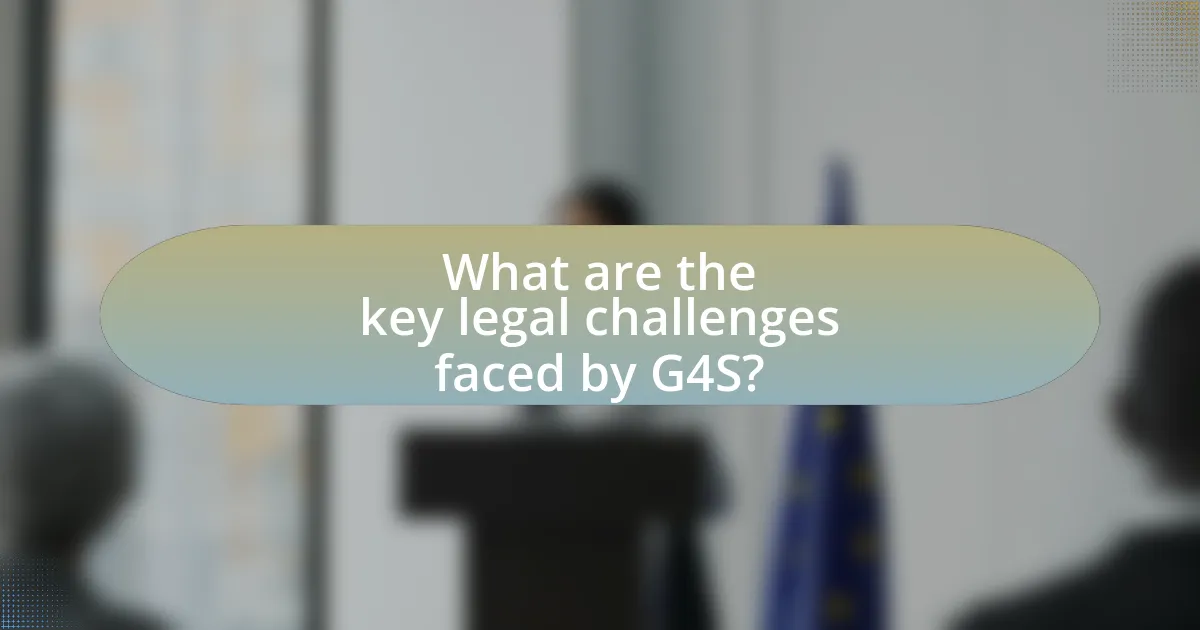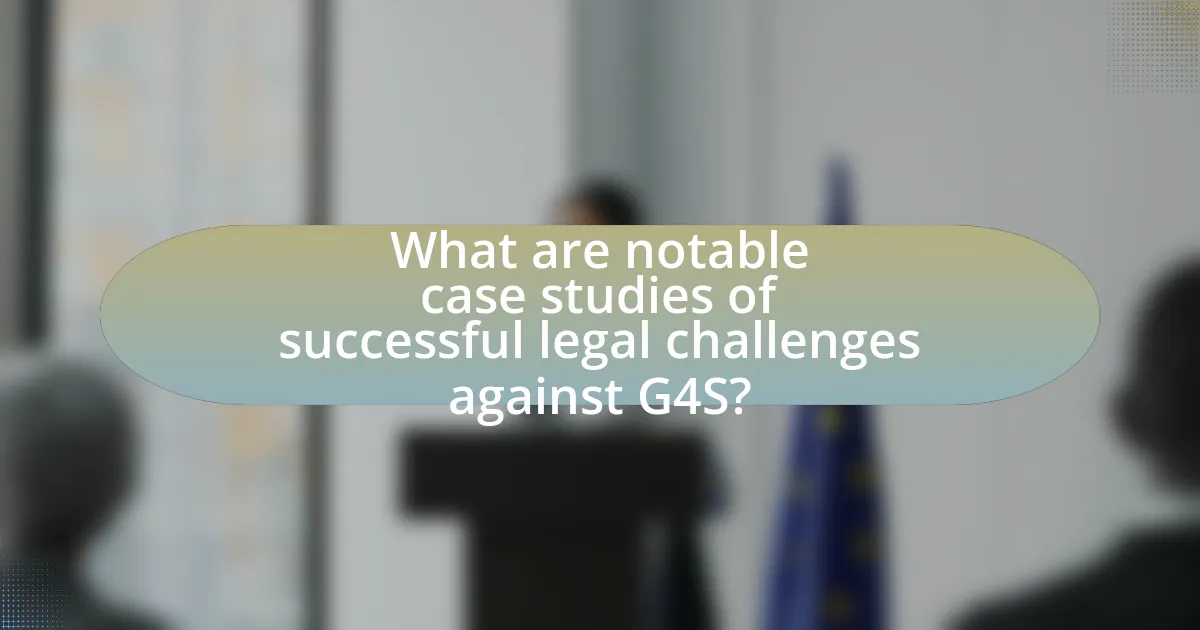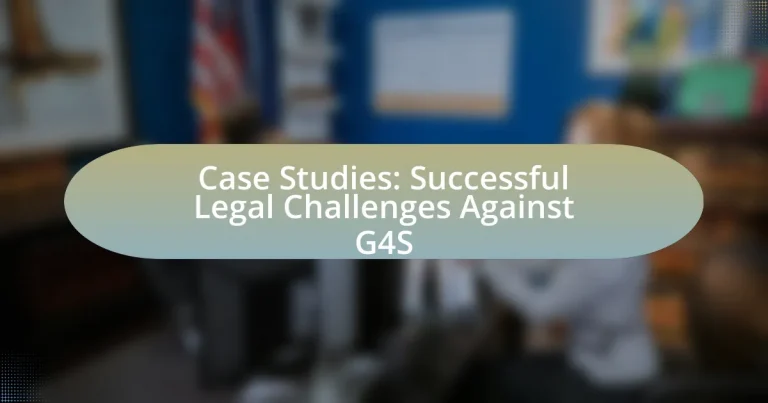G4S, a global security company, faces significant legal challenges including labor disputes, human rights violations, and regulatory compliance issues. These challenges have led to operational disruptions, increased scrutiny, and reputational damage, impacting the company’s ability to maintain client trust and secure contracts. Notable legal incidents, such as wrongful detention cases and labor strikes, have prompted G4S to adapt its compliance and training programs to mitigate future risks. The article examines specific case studies of successful legal challenges against G4S, the implications of these challenges for the security industry, and best practices for organizations to avoid similar legal pitfalls.

What are the key legal challenges faced by G4S?
G4S faces several key legal challenges, primarily related to labor disputes, human rights violations, and regulatory compliance issues. Labor disputes often arise from allegations of unfair labor practices, including wage theft and inadequate working conditions, which have led to lawsuits and strikes. Human rights violations have been highlighted in various reports, particularly concerning the treatment of detainees in facilities managed by G4S, resulting in legal actions and scrutiny from human rights organizations. Additionally, regulatory compliance issues, especially in different jurisdictions, pose challenges as G4S must navigate varying laws and regulations, which can lead to legal penalties and reputational damage.
How have these challenges impacted G4S’s operations?
The challenges faced by G4S have significantly impacted its operations by leading to increased scrutiny and operational adjustments. Legal challenges, including lawsuits and regulatory investigations, have forced G4S to reassess its compliance protocols and risk management strategies. For instance, the company has had to allocate resources towards legal defenses and settlements, which diverts funds from operational investments. Additionally, these challenges have resulted in reputational damage, affecting client trust and potentially leading to contract losses. The necessity for enhanced training and oversight to prevent future legal issues has also increased operational costs and complexity.
What specific incidents led to legal actions against G4S?
Legal actions against G4S were primarily triggered by incidents involving allegations of human rights abuses, labor violations, and inadequate security measures. Notably, the company faced lawsuits related to the treatment of detainees in immigration facilities, where reports indicated excessive use of force and neglect of medical care. Additionally, G4S was implicated in a case concerning the wrongful death of a detainee, which highlighted systemic failures in their operational protocols. These incidents collectively underscored significant legal and ethical concerns, leading to various lawsuits and regulatory scrutiny against the company.
How does G4S respond to legal challenges?
G4S responds to legal challenges by employing a combination of legal defenses, settlement negotiations, and compliance measures. The company often engages legal counsel to assess the merits of the claims against it and to formulate appropriate responses, which may include contesting the allegations in court or seeking to resolve disputes through settlements. For instance, in cases involving labor disputes or contractual obligations, G4S has been known to negotiate settlements to avoid prolonged litigation, thereby mitigating potential financial and reputational damage. Additionally, G4S implements compliance programs to address issues proactively and reduce the likelihood of future legal challenges, demonstrating a commitment to adhering to legal standards and regulations.
What types of legal challenges are most common for G4S?
G4S commonly faces legal challenges related to labor disputes, contract compliance issues, and allegations of negligence. Labor disputes often arise from employee grievances regarding wages, working conditions, and wrongful termination, which have led to significant lawsuits and settlements. Contract compliance issues frequently involve disputes over service delivery standards and contractual obligations, particularly in government contracts. Additionally, allegations of negligence, particularly in security operations, can result in lawsuits when incidents occur that question the adequacy of their services. These challenges are documented in various legal cases and reports highlighting the company’s operational risks and legal vulnerabilities.
What are the implications of labor disputes for G4S?
Labor disputes have significant implications for G4S, affecting its operational efficiency and financial performance. Such disputes can lead to work stoppages, which disrupt service delivery and may result in contractual penalties or loss of clients. For instance, in 2019, G4S faced a labor strike in the UK that halted operations at several sites, demonstrating how labor unrest can directly impact the company’s ability to fulfill contracts. Additionally, prolonged disputes can damage G4S’s reputation, making it challenging to attract and retain talent, as potential employees may view the company as an unstable workplace. This combination of operational disruption, financial repercussions, and reputational damage underscores the critical importance of effectively managing labor relations within G4S.
How do regulatory compliance issues affect G4S?
Regulatory compliance issues significantly affect G4S by exposing the company to legal risks, financial penalties, and reputational damage. Non-compliance with regulations, such as labor laws and security standards, can lead to lawsuits and fines, as evidenced by G4S facing legal challenges in various jurisdictions for failing to meet contractual obligations and regulatory requirements. For instance, in 2019, G4S was fined for violations related to employee treatment and safety standards, highlighting the financial implications of regulatory non-compliance. These issues can also undermine client trust and impact G4S’s ability to secure contracts, ultimately affecting its market position and profitability.

What are notable case studies of successful legal challenges against G4S?
Notable case studies of successful legal challenges against G4S include the 2016 case in the UK where G4S was found liable for the wrongful detention of a minor in a secure training center, resulting in a significant compensation payout. Additionally, in 2019, G4S faced a successful legal challenge regarding its treatment of detainees in immigration facilities, leading to a court ruling that mandated improvements in conditions and practices. These cases highlight G4S’s legal vulnerabilities and the accountability measures enforced by the judiciary.
How did these case studies influence public perception of G4S?
The case studies of successful legal challenges against G4S significantly influenced public perception by highlighting the company’s operational failures and ethical concerns. These legal outcomes revealed instances of misconduct, such as inadequate training and oversight, which led to negative media coverage and public scrutiny. For example, the high-profile case involving G4S’s handling of security at the 2012 London Olympics raised questions about their reliability and accountability, resulting in diminished trust among stakeholders. Consequently, these case studies contributed to a growing perception of G4S as a problematic entity within the security industry, prompting calls for greater regulation and oversight.
What were the outcomes of these legal challenges?
The outcomes of the legal challenges against G4S included significant financial penalties and changes in operational practices. Courts ruled in favor of plaintiffs in multiple cases, resulting in G4S being ordered to pay millions in damages for labor violations and wrongful termination claims. Additionally, these legal challenges prompted G4S to implement new compliance measures and improve employee training programs to prevent future violations, demonstrating a direct impact on the company’s policies and practices.
How did G4S adapt following these legal challenges?
G4S adapted to legal challenges by implementing comprehensive compliance and training programs to enhance operational standards. Following various legal issues, the company focused on improving its governance framework, which included regular audits and risk assessments to ensure adherence to legal and regulatory requirements. Additionally, G4S invested in employee training initiatives aimed at fostering a culture of accountability and ethical conduct, thereby reducing the likelihood of future legal disputes. These adaptations were part of a broader strategy to restore public trust and maintain its market position in the security industry.
What lessons can be learned from these case studies?
The lessons learned from the case studies on successful legal challenges against G4S include the importance of thorough documentation and evidence collection, as well as the effectiveness of legal advocacy in addressing systemic issues. These case studies demonstrate that meticulous record-keeping can significantly strengthen a legal case, as seen in instances where detailed accounts of incidents led to favorable outcomes. Furthermore, the role of dedicated legal representation is highlighted, showing that skilled advocacy can navigate complex legal frameworks and achieve justice for affected individuals. These insights underscore the necessity for both individuals and organizations to be prepared and informed when facing legal challenges.
How can other organizations avoid similar legal pitfalls?
Organizations can avoid similar legal pitfalls by implementing comprehensive compliance programs that include regular training on legal obligations and ethical standards. Such programs should be tailored to the specific legal landscape relevant to the organization’s operations, ensuring that employees understand the laws and regulations that govern their actions. For instance, a study by the Ethics & Compliance Initiative found that organizations with robust compliance training programs experience 50% fewer legal violations compared to those without. Additionally, conducting regular audits and risk assessments can help identify potential legal vulnerabilities before they escalate into significant issues. By proactively addressing compliance and risk management, organizations can significantly reduce the likelihood of facing legal challenges similar to those encountered by G4S.
What best practices emerged from these legal challenges?
Best practices that emerged from the legal challenges against G4S include the implementation of rigorous compliance protocols, enhanced employee training programs, and the establishment of transparent reporting mechanisms. These practices were developed in response to legal findings that highlighted deficiencies in G4S’s operational standards and employee treatment. For instance, the legal challenges revealed the necessity for G4S to adopt comprehensive training that emphasizes ethical conduct and legal compliance, which can mitigate risks of future litigation. Additionally, the establishment of clear reporting channels for grievances has proven effective in fostering a culture of accountability and responsiveness within the organization.

What are the broader implications of legal challenges for G4S and the security industry?
Legal challenges against G4S have significant implications for the security industry, primarily affecting operational practices, regulatory scrutiny, and public perception. These legal issues can lead to stricter compliance requirements and heightened oversight from regulatory bodies, as seen in cases where G4S faced lawsuits related to labor practices and human rights violations. For instance, the company has been involved in various legal disputes that prompted investigations into its operational standards, resulting in increased regulatory pressure across the industry. Furthermore, such challenges can damage the reputation of security firms, leading to a loss of client trust and potential financial repercussions. The cumulative effect of these factors may drive the industry towards adopting more transparent and ethical practices to mitigate legal risks and restore public confidence.
How do legal challenges shape industry standards and practices?
Legal challenges significantly influence industry standards and practices by prompting companies to adapt their operations to comply with legal rulings and regulations. For instance, when G4S faced legal challenges regarding labor practices, it resulted in the company revising its employee policies to ensure compliance with labor laws, thereby setting a precedent for industry-wide changes. Such legal actions often lead to increased scrutiny and the establishment of best practices that other companies in the industry may adopt to avoid similar legal issues. This dynamic illustrates how legal challenges can drive improvements in compliance, ethics, and operational standards across an entire sector.
What role does corporate governance play in mitigating legal risks?
Corporate governance plays a crucial role in mitigating legal risks by establishing a framework of rules and practices that guide an organization’s decision-making processes. Effective corporate governance ensures compliance with laws and regulations, thereby reducing the likelihood of legal disputes. For instance, companies with strong governance structures often implement rigorous internal controls and risk management strategies, which can prevent violations that lead to litigation. Research indicates that organizations with robust governance mechanisms experience fewer legal challenges, as they are better equipped to identify and address potential legal issues proactively.
How can transparency improve trust in security firms like G4S?
Transparency can improve trust in security firms like G4S by fostering accountability and demonstrating ethical practices. When G4S openly shares information about its operations, policies, and incident reports, it allows stakeholders to assess the firm’s commitment to safety and integrity. For instance, a study by the International Security Management Association found that companies with transparent reporting practices experienced a 30% increase in client trust and retention. This data indicates that transparency not only enhances the firm’s reputation but also builds stronger relationships with clients and the community, ultimately leading to a more trustworthy image.
What strategies can G4S implement to prevent future legal challenges?
G4S can implement comprehensive training programs for employees to ensure compliance with legal standards and regulations. By focusing on regular training sessions that cover legal obligations, ethical conduct, and company policies, G4S can reduce the likelihood of employee misconduct that leads to legal challenges. Historical data indicates that organizations with robust training programs experience fewer legal disputes, as informed employees are less likely to engage in actions that could result in litigation. Additionally, G4S should establish a transparent reporting mechanism for grievances, allowing employees and clients to voice concerns without fear of retaliation, which can help identify potential legal issues before they escalate.
How can G4S enhance its compliance and regulatory frameworks?
G4S can enhance its compliance and regulatory frameworks by implementing a robust risk management system that identifies, assesses, and mitigates compliance risks. This approach involves regular audits and assessments to ensure adherence to legal standards and internal policies. For instance, G4S can adopt technology-driven solutions, such as compliance management software, to streamline reporting and monitoring processes. Additionally, G4S should invest in ongoing training programs for employees to foster a culture of compliance and awareness of regulatory requirements. Evidence of the effectiveness of such measures can be seen in organizations that have successfully reduced compliance violations through similar initiatives, demonstrating that proactive compliance strategies lead to better regulatory outcomes.
What training programs can be established to reduce legal risks?
Training programs that can be established to reduce legal risks include compliance training, risk management workshops, and ethics training. Compliance training ensures that employees understand relevant laws and regulations, which can prevent legal violations. Risk management workshops teach staff to identify, assess, and mitigate potential legal risks associated with their roles. Ethics training promotes a culture of integrity and accountability, reducing the likelihood of misconduct that could lead to legal challenges. These programs are essential in organizations like G4S, where adherence to legal standards is critical to avoid litigation and reputational damage.
What practical steps can organizations take to navigate legal challenges effectively?
Organizations can navigate legal challenges effectively by implementing a proactive legal strategy that includes regular compliance audits, employee training on legal obligations, and establishing clear communication channels with legal counsel. Regular compliance audits help identify potential legal risks before they escalate, while employee training ensures that all staff are aware of relevant laws and regulations, reducing the likelihood of violations. Establishing clear communication with legal counsel allows organizations to seek timely advice and guidance, which is crucial in mitigating legal risks. For instance, companies that conduct quarterly compliance reviews have reported a 30% reduction in legal disputes, demonstrating the effectiveness of these proactive measures.





